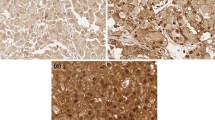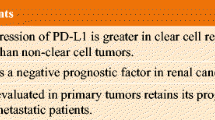Abstract
In the context of cancer immunotherapy, PD-1 as well as PD-L1 has been widely studied in renal cell carcinoma (RCC). PD-1 and PD-L1 play a significant role as prognostic markers in clear cell renal cell carcinoma. In contrast, little is known about PD-L2 expression patterns in RCC, especially in rarer subtypes. The aim of this study was to evaluate the prevalence, distribution and prognostic impact of PD-L2 expression in chromophobe (ch)RCC. Eighty-one patients who underwent renal surgery due to chRCC were retrospectively evaluated. Tumor specimens were analyzed for PD-L2 expression by immunohistochemistry. Expression data were associated with clinicopathological parameters and overall survival (OS). Twenty-three (28.4%) patients showed a PD-L2 > median (PD-L2 high) staining intensity. No significant association between clinicopathological parameters and PD-L2 expression was identified. A significant difference between 5- and 10-year OS in dependence of PD-L2 expression was found (PD-L2 low 96.4 and 87.7% vs. PD-L2 high 87.1 and 56%; log rank, p = 0.029). However, in multivariate analysis PD-L2 expression failed to be proofed as an independent prognostic factor. In conclusion, to our knowledge this is the first study evaluating the prognostic impact of PD-L2 in a considerably large cohort of chRCC. Our results showed a significant diminished OS in dependence of PD-L2 expression. This implicates that PD-L2 might play a role as prognostic marker in chRCC demanding further evaluation.


Similar content being viewed by others
Abbreviations
- chRCC:
-
Chromophobe renal cell carcinoma
- ccRCC:
-
Clear cell renal cell carcinoma
- CD:
-
Cluster of differentiation
- IHC:
-
Immunohistochemistry
- LN:
-
Lymph node metastasis
- OS:
-
Overall survival
- PD-1:
-
Programmed death 1
- PD-L1:
-
Programmed death ligand 1
- PD-L2:
-
Programmed death ligand 2
- RCC:
-
Renal cell carcinoma
- TIMC:
-
Tumor-infiltrating mononuclear immune cells
- TMA:
-
Tissue microarray
References
Pardoll DM. The blockade of immune checkpoints in cancer immunotherapy. Nat Rev Cancer. 2012;12(4):252–64.
Brahmer JR, Tykodi SS, Chow LQ, et al. Safety and activity of anti-PD-L1 antibody in patients with advanced cancer. N Engl J Med. 2012;366(26):2455–65.
Topalian SL, Hodi FS, Brahmer JR, et al. Safety, activity, and immune correlates of anti-PD-1 antibody in cancer. N Engl J Med. 2012;366(26):2443–54.
Ishida Y, Agata Y, Shibahara K, Honjo T. Induced expression of PD-1, a novel member of the immunoglobulin gene superfamily, upon programmed cell death. EMBO J. 1992;11(11):3887–95.
Terme M, Ullrich E, Aymeric L, et al. IL-18 induces PD-1-dependent immunosuppression in cancer. Cancer Res. 2011;71(16):5393–9.
Freeman GJ, Long AJ, Iwai Y, et al. Engagement of the PD-1 immunoinhibitory receptor by a novel B7 family member leads to negative regulation of lymphocyte activation. J Exp Med. 2000;192(7):1027–34.
Riella LV, Paterson AM, Sharpe AH, Chandraker A. Role of the PD-1 pathway in the immune response. Am J Transpl. 2012;12(10):2575–87.
Latchman Y, Wood CR, Chernova T, et al. PD-L2 is a second ligand for PD-1 and inhibits T cell activation. Nat Immunol. 2001;2(3):261–8.
Taube JM, Klein A, Brahmer JR, et al. Association of PD-1, PD-1 ligands, and other features of the tumor immune microenvironment with response to anti-PD-1 therapy. Clin Cancer Res. 2014;20(19):5064–74.
Thompson RH, Dong H, Kwon ED. Implications of B7-H1 expression in clear cell carcinoma of the kidney for prognostication and therapy. Clin Cancer Res. 2007;13(2 Pt 2):709s–15s.
Thompson RH, Kuntz SM, Leibovich BC, et al. Tumor B7-H1 is associated with poor prognosis in renal cell carcinoma patients with long-term follow-up. Cancer Res. 2006;66(7):3381–5.
Abbas M, Steffens S, Bellut M, et al. Do programmed death 1 (PD-1) and its ligand (PD-L1) play a role in patients with non-clear cell renal cell carcinoma? Med Oncol. 2016;33(6):59.
Erlmeier F, Hartmann A, Autenrieth M, et al. PD-1/PD-L1 expression in chromophobe renal cell carcinoma: an immunological exception? Med Oncol. 2016;33(11):120.
Shin SJ, Jeon YK, Kim PJ, et al. Clinicopathologic analysis of PD-L1 and PD-L2 expression in renal cell carcinoma: association with oncogenic proteins status. Ann Surg Oncol. 2016;23(2):694–702.
Erlmeier F, Feuchtinger A, Borgmann D, et al. Supremacy of modern morphometry in typing renal oncocytoma and malignant look-alikes. Histochem Cell Biol. 2015;144(2):147–56.
Steffens S, Schrader AJ, Blasig H, et al. Caveolin 1 protein expression in renal cell carcinoma predicts survival. BMC Urol. 2011;11:25.
Steffens S, Schrader AJ, Vetter G, et al. Fibronectin 1 protein expression in clear cell renal cell carcinoma. Oncol Lett. 2012;3(4):787–90.
Akhtar M, Kardar H, Linjawi T, McClintock J, Ali MA. Chromophobe cell carcinoma of the kidney: a clinicopathologic study of 21 cases. Am J Surg Pathol. 1995;19(11):1245–56.
Moch H, Gasser T, Amin MB, Torhorst J, Sauter G, Mihatsch MJ. Prognostic utility of the recently recommended histologic classification and revised TNM staging system of renal cell carcinoma: a Swiss experience with 588 tumors. Cancer. 2000;89(3):604–14.
Fuhrman SA, Lasky LC, Limas C. Prognostic significance of morphologic parameters in renal cell carcinoma. Am J Surg Pathol. 1982;6(7):655–63.
Renshaw AA, Henske EP, Loughlin KR, Shapiro C, Weinberg DS. Aggressive variants of chromophobe renal cell carcinoma. Cancer. 1996;78(8):1756–61.
Thompson RH, Dong H, Lohse CM, et al. PD-1 is expressed by tumor-infiltrating immune cells and is associated with poor outcome for patients with renal cell carcinoma. Clin Cancer Res. 2007;13(6):1757–61.
Abbas M, Steffens S, Bellut M, et al. Intratumoral expression of programmed death ligand 1 (PD-L1) in patients with clear cell renal cell carcinoma (ccRCC). Med Oncol. 2016;33(7):80.
Herbst RS, Soria JC, Kowanetz M, et al. Predictive correlates of response to the anti-PD-L1 antibody MPDL3280A in cancer patients. Nature. 2014;515(7528):563–7.
Acknowledgements
The authors would like to thank Ulrike Muehlthaler for her assistance with the PD-L2 immunohistochemistry.
Funding
This work was supported by a grant from the Deutsche Forschungsgemeinschaft (DFG) (Grant No. ER 795/1-1, Franziska Erlmeier).
Author information
Authors and Affiliations
Contributions
FE, PI and SS participated in the data interpretation and drafting of the manuscript. PI and SS performed the statistical analysis. MW carried out clinical data acquisition. FE carried out the pathological data acquisition. WW, AH, MA and AJS contributed to data interpretation and revised the manuscript for important intellectual content. All authors read and approved the final manuscript.
Corresponding author
Ethics declarations
Conflict of interest
The authors have declared no conflicts of interest.
Ethical standards
All procedures have been approved by the appropriate ethics committee and have therefore been performed in accordance with the ethical standards laid down in the 1964 Declaration of Helsinki and its later amendments. Informed consent was assessed prior to intervention. Analyses were performed in concordance with recommendations of the ethics commission of the Technical University of Munich and ethic comity approval (384/13). Details that disclose the identity of the subjects under study were omitted.
Additional information
Philipp Ivanyi and Sandra Steffens have contributed equally to this work.
Rights and permissions
About this article
Cite this article
Erlmeier, F., Weichert, W., Autenrieth, M. et al. PD-L2: A prognostic marker in chromophobe renal cell carcinoma?. Med Oncol 34, 71 (2017). https://doi.org/10.1007/s12032-017-0926-1
Received:
Accepted:
Published:
DOI: https://doi.org/10.1007/s12032-017-0926-1




